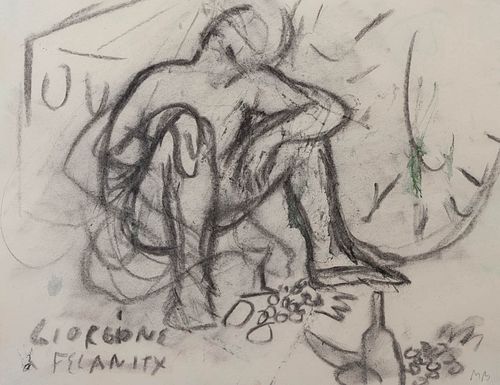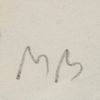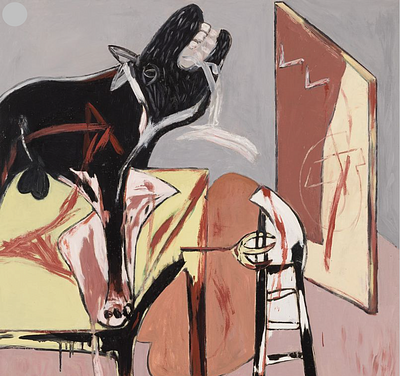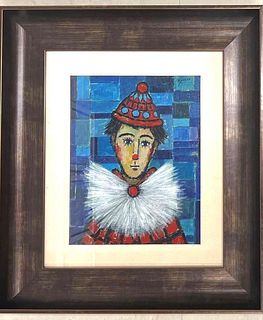MIQUEL BARCELÓ ARTIGUES (Felanitx, Mallorca, 1957). "Giorgione à Felanitx", 1984. Mixed media on paper.
Lot 91
About Seller
Setdart Auction House
Carrer Aragó 346
Barcelona
Spain
Setdart Subastas was born in 2004 and is currently the first online art auction in Spain with solidity, prestige and reliability guaranteed by our more than 60,000 users. Setdart has a young, dynamic and enterprising team ready to successfully manage the purchase and sale of art works through custom...Read more
Categories
Estimate:
EUR€12,000 - EUR€15,000
$12,903.23 - $16,129.03
Absentee vs Live bid
Two ways to bid:
- Leave a max absentee bid and the platform will bid on your behalf up to your maximum bid during the live auction.
- Bid live during the auction and your bids will be submitted real-time to the auctioneer.
Bid Increments
| Price | Bid Increment |
|---|---|
| EUR€0 | EUR€10 |
| EUR€200 | EUR€25 |
| EUR€500 | EUR€50 |
| EUR€1,000 | EUR€100 |
| EUR€3,000 | EUR€200 |
| EUR€5,000 | EUR€500 |
| EUR€10,000 | EUR€1,000 |
| EUR€20,000 | EUR€2,000 |
| EUR€50,000 | EUR€5,000 |
About Auction
By Setdart Auction House
Nov 16, 2021
Set Reminder
2021-11-16 08:00:00
2021-11-16 08:00:00
America/New_York
Bidsquare
Bidsquare : Contemporary and Actual Art
https://www.bidsquare.com/auctions/setdart-auction-house/contemporary-and-actual-art-7839
Setdart Auction House sofia@setdart.com
Setdart Auction House sofia@setdart.com
- Lot Description
MIQUEL BARCELÓ ARTIGUES (Felanitx, Mallorca, 1957). "Giorgione à Felanitx", 1984. Mixed media on paper. Titled and signed with initials in the lower margin. With Bischofberger gallery label on the back. Measurements: 24 x 31,5 cm; 44,5 x 54 cm (frame). The decade of the 80's was one of the most important in Miquel Barceló's plastic arts, since it meant his international recognition. It began with his establishment in Barcelona in 1980, and he exhibited in several European cities. He participated in the São Paulo Biennial (1981) and the Documenta in Kassel (1982). In 1986, he showed his work for the first time in the United States (specifically, at the Leo Castelli Gallery in New York). Two years earlier he had already exhibited his work for the first time with Bruno Bischofberger, and met Cécile Franken, whom he would marry. In 1987 he settled in Paris and, the following year, he traveled for the first time to Africa, another important geographical reference in his career. The work we are dealing with becomes a sketch for the imposing painting "Giorgione a Felanitx", a large format canvas (300 x 200 cm) also painted in 1984, which alludes to Giorgione, one of the most admired painters of the Mallorcan. A painter and sculptor, Barceló began his training at the School of Arts and Crafts in Palma de Mallorca, where he studied between 1972 and 1973. In 1974 he made his individual debut, at the age of seventeen, at the Picarol Gallery in Mallorca. That same year he moved to Barcelona, where he enrolled at the Sant Jordi School of Fine Arts, and made his first trip to Paris. In the French capital he discovers the work of Paul Klee, Fautrier, Wols and Dubuffet, as well as the "art brut", a style that will exert an important influence on his first paintings. During these years he reads extensively, and enriches himself with works as diverse as the writings of Breton and the surrealists, the "White Manifesto" by Lucio Fontana or the "Social History of Literature and Art" by Arnold Hauser. In 1976 he held his first solo exhibition in a museum: "Cadaverina 15" at the Museum of Mallorca, consisting of a montage of 225 wooden boxes with glass lids, with decomposing organic materials inside. That same year, back in Mallorca, he joined the Taller Lunàtic group and took part in its social, political and cultural events. In 1977 he makes a second trip to Paris, and also visits London and Amsterdam. That same year he exhibits for the first time in Barcelona, and meets Javier Mariscal, who will become one of his best friends in the city. It was also in 1977 when he received his first large-scale painting commission: a mural for the dining room of a hotel in Cala Millor, Mallorca. The following year, at the age of twenty-one, he sells his first works to some collectors and galleries, and finally moves to Barcelona. His international recognition began in the early eighties. In 1986 he was awarded the Premio Nacional de Artes Plásticas, and since then his work has been recognized through the most outstanding awards, such as the Premio Príncipe de Asturias de las Artes (2003) or the Sorolla Prize of the Hispanic Society of America in New York (2007). Barceló is currently represented in the most important contemporary art museums in the world, such as the MoMA in New York, the Centre Pompidou in Paris, the Guggenheim in Bilbao, the Marugami Hirai in Japan, the Reina Sofía in Madrid, the Patio Herreriano in Valladolid, the CAPC in Bordeaux, the Carré d'Art in Nimes, the Museum of Contemporary Art in Caracas and the Museum of Fine Arts in Boston, among others.
- Shipping Info
-
In-house shipping available. Please inquire at admin@setdart.com.
-
- Buyer's Premium



 EUR
EUR CAD
CAD AUD
AUD GBP
GBP MXN
MXN HKD
HKD CNY
CNY MYR
MYR SEK
SEK SGD
SGD CHF
CHF THB
THB
















